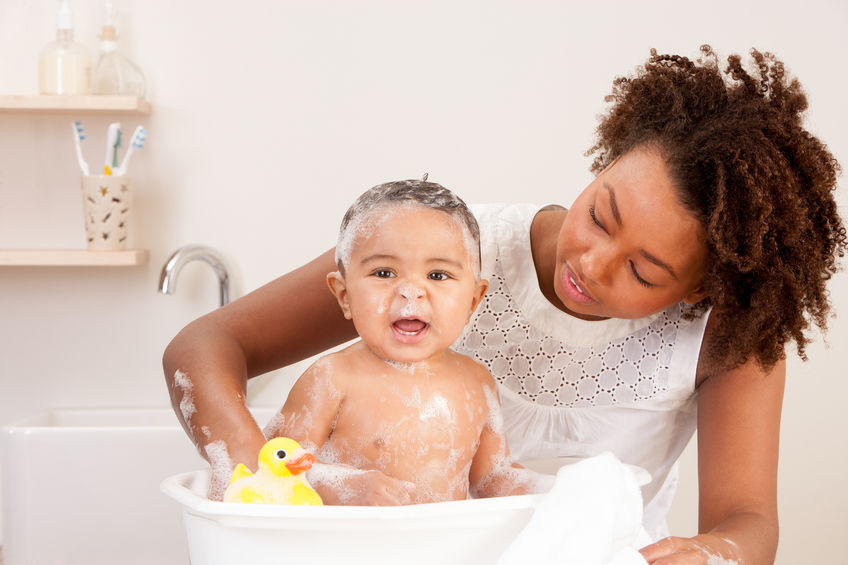
Bath time can be a fun way for babies and parents to spend time together, but it can also quickly turn into a parent’s worst nightmare if safety precautions are not taken. It can be easy for your baby to drown or have their skin scalded by hot water if you aren’t careful with the bath.
However, bath time doesn’t have to be scary. By following a few simple steps, you can keep bath time safe and fun for the both of you.
Read Next | How to Safely Introduce Your Newborn to Visitors during the Coronavirus Pandemic
1. NEVER leave baby unsupervised
Your baby can drown in just an inch of water – and it only takes a second of turning your back before the worst can happen. As such, you should never leave your baby unsupervised in the bath regardless of how little water there may be or how quickly you plan to return.
Plan your baby’s bath accordingly. Keep everything you will need within reach, including soaps, toys, and towels. Don’t go searching for something you may have forgotten. Ask someone else to bring any items to you or just take your baby with you if you ever need to leave the room.
If the phone rings when you are expecting an important call, plan on wrapping your baby up in a towel to take them with you rather than leaving them to answer. Better yet, just let it go to voicemail and get back to them later.
Read Next | This Is How Exercise can Help with Postpartum Depression
2. DON’T put baby in the tub while water is running
Before you put your baby in the bath, you should always have the water already in the tub at the correct depth and temperature. Putting your baby into the bath while the water is still running can be very dangerous.
Firstly, water temperature tends to fluctuate in a running tap. You can have drops that are too cold or spikes that are so hot they can easily burn your baby’s skin. There is also a risk of overfilling the tub if you leave the water running while your baby is inside.
Another thing many parents don’t think about is the sensitivity of their baby’s ears. The sound of rushing water from the tap can be too loud and intense for a small baby, making the bath a frightening place rather than somewhere relaxing and fun.
3. ALWAYS regulate water temperature
Speaking of temperature, you need to keep a close eye on your hot water heater and the temperature of your baby’s bath water as their skin is more sensitive and susceptible to burns at a lower temperature than an adult’s.
It is highly advised that you lower the maximum heat on your water heater so there is never a mistake of your baby’s bath water being too hot. Try to keep it around 120 degrees Fahrenheit (48.9 degrees Celsius) or lower.
Before you place your baby in the bath water, be sure to test the temperature with your wrist or the inside of your elbow. These areas are more sensitive and give you a better idea of what the water will feel like against your baby’s skin.
You can also purchase a baby-friendly bath thermometer so there is never a question of what temperature the water is and if it’s suitable for your baby.
Read Next | Healthy Development: The Importance of Positive Interactions with Baby
4. ONLY use baby-safe shampoos and soaps
Babies’ skin sensitivity is also affected by the type of soaps that come into contact with it. Adult soaps and shampoos are often too harsh on a baby’s skin and can cause drying, allergies, or rashes.
Start by giving your newborn a sponge bath or bathing them with only water. From there, you can look for a soap and/or shampoo that is formulated especially for babies. These can usually be found in the baby section of the supermarket.
You should also avoid bubble baths, especially for little girls (the soap and bubbles can irritate the vagina), until your child is older. The soap used in bubble bath solutions can irritate the urethra in both boys and girls and potentially cause urinary tract infections (UTIs).
5. INVEST in child-proofing your tub
Needless to say, the family tub isn’t created with babies in mind. It’s big, slippery, and that faucet is sharp enough to even take a gouge out of an adult’s skin. What you need to do is invest in a few products that will make your tub a bit more child-proof.
- A non-slip bath mat can create a better surface grip on the floor of the tub.
- A baby bath or bath separator can be purchased to create a smaller bath space for your little one to play and bathe.
- A baby-friendly spout cover can soften the sharp metal edges and make it more fun and engaging for your child.
- A bath thermometer (as previously mentioned) can help you monitor the bath water temperature and keep your baby safe.
- If your shower/bath has sliding glass doors, make sure they are made with safety glass that will not shatter. Also, be sure to keep shower curtains out of your child’s reach while they are bathing.
6. PRACTICE safe bath time habits
A safe bath should not only be a closely monitored and protective one, but it should also be a time to instill good habits in your child as they will eventually begin to spend time alone in the tub in the future.
- Teach your child to sit in the tub at all times, even if you have a non-slip mat installed.
- Keep all electrical appliances and hair tools far away from the tub and out of reach.
- Allow play time at the beginning of the bath so your child isn’t sitting in soapy water that can irritate the skin.
- Only bathe your little one a couple of times per week as frequent baths can dry out the skin.
- Fill the tub with water no higher than your child’s waist when sitting (about 2 to 4 inches).
- Keep the room relatively warm (about 75 degrees Fahrenheit or 25 degrees Celsius) to prevent your child from getting too cold while sitting in the bath.
- Have clothes and diaper already selected and laid out so you can quickly dress your child after their bath to prevent them from becoming too cold.
By following these simple bath practices with your little one, you can make bath time both safe and fun for both of you. It can become a nice bonding and play time for parent and baby without worrying about any injury befalling your child.

Read Next | Agreement Terms You Should Include in Your Nanny Contract
Baby Journey is a parenting blog that shares guides and tips on taking care of babies & toddlers.
Like what you read? JOIN the Mommybites community to get the latest on FREE online classes, parenting advice, events, childcare listings, casting calls & raffles, and our Parents With Nannies Facebook group. SIGN UP NOW!



